Related Research Articles
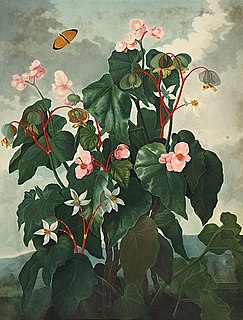
Begonia is a genus of perennial flowering plants in the family Begoniaceae. The genus contains more than 2,000 different plant species. The Begonias are native to moist subtropical and tropical climates. Some species are commonly grown indoors as ornamental houseplants in cooler climates. In cooler climates some species are cultivated outside in summertime for their bright colorful flowers, which have sepals but no petals.

Tropaeolum, commonly known as nasturtium, is a genus of roughly 80 species of annual and perennial herbaceous flowering plants. It was named by Carl Linnaeus in his book Species Plantarum, and is the only genus in the family Tropaeolaceae. The nasturtiums received their common name because they produce an oil similar to that of watercress.

Dahlia is a genus of bushy, tuberous, herbaceous perennial plants native to Mexico and Central America. A member of the Compositae family of dicotyledonous plants, its garden relatives thus include the sunflower, daisy, chrysanthemum, and zinnia. There are 42 species of dahlia, with hybrids commonly grown as garden plants. Flower forms are variable, with one head per stem; these can be as small as 5 cm (2 in) diameter or up to 30 cm (1 ft). This great variety results from dahlias being octoploids—that is, they have eight sets of homologous chromosomes, whereas most plants have only two. In addition, dahlias also contain many transposons—genetic pieces that move from place to place upon an allele—which contributes to their manifesting such great diversity.
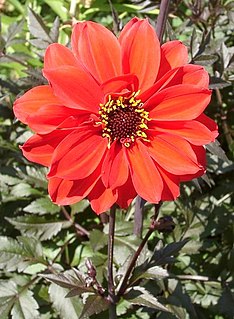
'Bishop of Llandaff' is a cultivar of the dahlia, a garden plant. It is a branching, tuberous tender perennial with dark purple, almost black, foliage. This produces a stunning contrast with its scarlet flowers. The plant was first bred by Fred Treseder, a Cardiff nurseryman. It was selected by and named to honour Joshua Pritchard Hughes, Bishop of Llandaff, in 1924 and won the RHS Award of Garden Merit in 1928. The plant is about 1 m tall and flowers from June until September. As with all dahlias, frost blackens its foliage, and in areas prone to frost its tubers need to be overwintered in a dry, frost-free place.

Pelargonium is a genus of flowering plants that includes about 280 species of perennials, succulents, and shrubs, commonly called as geraniums, pelargoniums, or storksbills. Geranium is also the botanical name and common name of a separate genus of related plants, also known as cranesbills. Both genera belong to the family Geraniaceae. Carl Linnaeus originally included all the species in one genus, Geranium, and they were later separated into two genera by Charles Louis L'Héritier de Brutelle in 1789.

Alstroemeria, commonly called the Peruvian lily or lily of the Incas, is a genus of flowering plants in the family Alstroemeriaceae. They are all native to South America although some have become naturalized in the United States, Mexico, Australia, New Zealand, Madeira and the Canary Islands. Almost all of the species are restricted to one of two distinct centers of diversity, one in central Chile, the other in eastern Brazil. Species of Alstroemeria from Chile are winter-growing plants while those of Brazil are summer growing. All are long-lived perennials except A. graminea, a diminutive annual from the Atacama Desert of Chile.

Magnolia grandiflora, commonly known as the southern magnolia or bull bay, is a tree of the family Magnoliaceae native to the southeastern United States, from Virginia to central Florida, and west to East Texas. Reaching 27.5 m (90 ft) in height, it is a large, striking evergreen tree, with large dark green leaves up to 20 cm long and 12 cm wide, and large, white, fragrant flowers up to 30 cm (12 in) in diameter.

Anemone coronaria, the poppy anemone, Spanish marigold, or windflower, is a species of flowering plant in the buttercup family Ranunculaceae, native to the Mediterranean region.
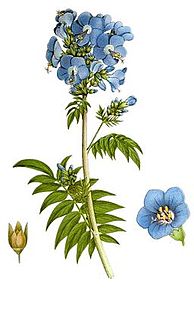
Polemonium caeruleum, known as Jacob's-ladder or Greek valerian, is a hardy perennial flowering plant. The plant produces cup-shaped, blue or white flowers. It is native to temperate regions of Europe.

Lagerstroemia indica, the crape myrtle is a species of flowering plant in the genus Lagerstroemia of the family Lythraceae. It is native to the Indian Subcontinent, and also to Southeast Asia, China, Korea and Japan. The genus name honors Swedish botanist Magnus von Lagerstroem. It is an often multi-stemmed, deciduous tree with a wide spreading, flat topped, rounded, or even spike shaped open habit. The tree is a popular nesting shrub for songbirds and wrens.

Argyranthemum frutescens, known as Paris daisy, marguerite or marguerite daisy, is a perennial plant known for its flowers. It is native to the Canary Islands. Hybrids derived from this species are widely cultivated as ornamental plants in private gardens and public parks in many countries, and have naturalized in Italy and southern California. There are many cultivars, but the most common has white petals.

Bedding, in horticulture, refers to the temporary planting of fast-growing plants into flower beds to create colourful, temporary, seasonal displays, during spring, summer or winter. Plants used for bedding are generally annuals, biennials or tender perennials; succulents are gaining in popularity.

Cyclamen hederifolium, the ivy-leaved cyclamen or sowbread, is a species of flowering plant in the family Primulaceae. This widespread cyclamen species is widely cultivated and among the most hardy and vigorous in oceanic climates. It is native to woodland, shrubland, and rocky areas in the Mediterranean region from southern France to western Turkey and on Mediterranean islands, and naturalized farther north in Europe and in the Pacific Northwest.
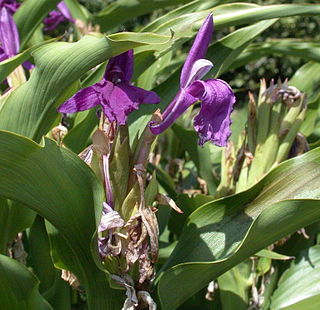
Roscoea auriculata is a perennial herbaceous plant occurring in the eastern Himalayas, in Tibet, Bhutan, Nepal and Sikkim. Most members of the ginger family (Zingiberaceae), to which it belongs, are tropical, but R. auriculata, like other species of Roscoea, grows in much colder mountainous regions. It is sometimes grown as an ornamental plant in gardens.

Roscoea humeana is a species of flowering plant in the Zingiberaceae family. It is a perennial occurring in the Sichuan and Yunnan provinces of China. Most members of the ginger family, to which it belongs, are tropical, but R. humeana, like other species of Roscoea, grows in much colder mountainous regions. It is sometimes grown as an ornamental plant in gardens.

Hibiscus 'Kopper King' is a cultivar of Hibiscus that has large, showy flowers and copper-colored lobed leaves. It was bred and selected for its aesthetic attributes as well as its cold hardiness to at least −30 °F (−34 °C) by Jim, Bob, and Dave Fleming of Fleming's Flower Fields in Lincoln, Nebraska. 'Kopper King' is a compact perennial shrub, reaching 3–4 ft (0.9–1.2 m) tall with a 2–4 ft (0.6–1.2 m) spread. The leaves are coppery red to dark purple, with a lobed and toothed leaf shape that appears to be similar to some maples. New growth will emerge in late May or early June and the plant will bloom from midsummer to early fall at the first frost. Each flower, with its cream to light-pink petals and deep red eye in the center streaking outward toward the margin, is borne singly from the leaf axils and can be 8–12 in (20.3–30.5 cm) in diameter. Each flower only lasts one day but new blooms are typically produced in succession, allowing for almost continuous flowering. The flower display is flat with petals overlapping. Overall, the plant is resistant to pests and diseases, although it can be severely damaged by Japanese beetles.

Roscoea wardii is a perennial herbaceous plant occurring from eastern Arunachal Pradesh in India to western Yunnan in China. Most members of the ginger family (Zingiberaceae), to which it belongs, are tropical, but like other species of Roscoea, R. wardii grows in much colder mountainous regions.

Iris orientalis is a species in the genus Iris; it is also in the subgenus Limniris and in the series Spuriae. It is a rhizomatous perennial plant, from Turkey and Greece, with white flowers with a yellow mark or blotch. It was also known as Iris ochroleuca for a long time. It is commonly known as yellow banded iris in the U.S. and Turkish iris in the UK but also has some other less common names. It is very hardy and has been known to naturalize in various countries. It is widely cultivated as an ornamental plant in temperate regions.
Iris cypriana is a plant species in the genus Iris, it is also in the subgenus Iris. It is a rhizomatous perennial, from Cyprus. It has narrow, glaucous and evergreen leaves, tall slender stem, with 2–3 branches, and 1–3 large flowers in lavender, lilac, red-lilac, to dark purple shades. It is cultivated as an ornamental plant in temperate regions. It is listed in some sources as a synonym of Iris germanica.
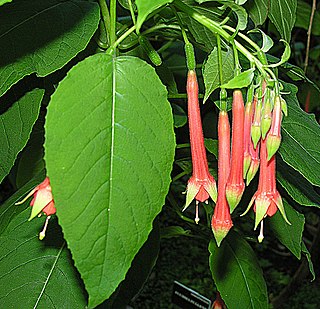
Fuchsia fulgens is a plant of the genus Fuchsia native to Mexico and Central America.
References
- ↑ Dahlias.co.uk
- ↑ "The American Dahlia Society" . Retrieved 2020-05-05.
- ↑ Nash, Kim Ruddock-last modified by June. "Naming Rules". National Dahlia Society. Retrieved 2020-05-05.
- ↑ Ruddock, Kim. "Classification". National Dahlia Society. Retrieved 2020-05-05.
- ↑ "KAVB | Registration". www.kavb.nl. Retrieved 2020-05-05.